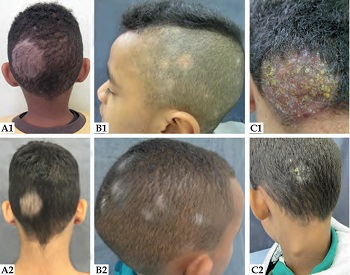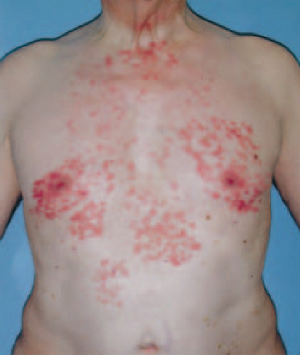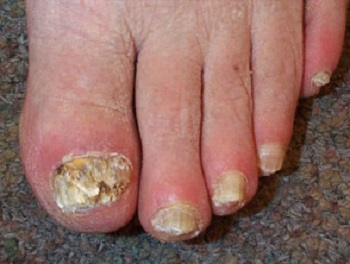Trichophyton tonsurans - Clinical manifestation
Clinical manifestation of Trichophyton tonsurans
Clinical manifestations of Trichophyton tonsurans include Tinea capitis (most common), Tinea corporis, onychomycosis, and Tinea pedis.
Tinea capitis
tinea capitis, caused by Trichophyton tonsurans, is a cutaneous fungal infection of the scalp
this dermatophytosis is also known as herpes tonsurans, ringworm of the scalp, scalp ringworm, ringworm of the hair, tinea tonsurans
fungal invasion of the hair shaft results in single or multiple patches of hair loss or a 'black dot' pattern due to broken-off hairs
associated symptoms include thickening scaling, itching, pustules, dandruff (seborrheic dermatitis), boggy swelling, expanding red rings, and inflammation of the scalp
may also lack clinical symptoms
most common in pre-pubertal male children
Trichophyton tonsurans is the causative agent of a condition known as a black dot
Black dot
Trichophyton tonsurans invade hairs and abundantly sporulate in the hair shaft (endothrix).
as a result, the infected hair bursts and curl with hair breaking off near the surface of the scalp, resulting in a black dot on the smooth scalp surface

Tinea capitis (Source: SciELO)
Tinea corporis
tinea corporis, caused by Trichophyton tonsurans, is a fungal infection of the body – the arms and legs
more common on glabrous skin i.e. where there is a lack of hair but may occur on any superficial part of the body
marked by enlarging raised red rings with a light central area (ringworm_
symptoms include itching, an elevated rash with scaly touch, hair loss in the infected area
the skin surrounding the rash appears dry and flaky

Tinea corporis (Source: Semantic Scholar)
Tinea unguium
Trichophyton tonsurans is one of the causative agents of tinea unguium
also known as Distal subungual onychomycosis
fungal infection of the nail (toenail or fingernail)
invades the nail bed and underside of the nail plate
symptoms include white, black, green, or yellow nail discoloration, thickening of the nail, separation of the nail from the nail bed
in chronic cases, nails may become brittle with pieces or whole nails breaking off
in untreated cases, the skin underneath and around the nail can become inflamed and painful
no pain or other bodily symptoms unless the disease is severe
does not necessarily require treatment but oral antifungal medicine is effective (associated with liver problems)
Complication of tinea unguium
A complication of tinea unguium, caused by Trichophyton rubrum, is cellulitis.

Tinea unguium (Source: dermnetnz)
Tinea pedis
tinea pedis, also known as athlete's foot, is a common clinical manifestation of Trichophyton rubrum infection
infection of the foot, toes, interdigital web spaces
warmth and moisture produced by the shoes aid in establishing and maintaining infection
commonly seen in individuals wearing shoes for long hours
symptoms include itching, scaling, cracking, redness, and in rare cases skin blisters to ulcerative
although any area of the foot may be infected, areas between toes are most commonly infected
chronic cases may result in the moccasin foot in which the entire foot forms white scaly patches
the moccasin foot is mostly asymptomatic with slightly erythematous plaques on the sole of the foot and is covered by hyperkeratotic scales
can be divided into four categories -
* chronic interdigital
* plantar (moccasin foot)
* acute ulcerative
* vesiculobullous

Tinea pedis (Source: Clear Skin)
Chronic interdigital
most common
occurs between toes
syndromes include maceration, fissuring erythema, scaling in toe webs
mostly found between the fourth and fifth toes
Plantar (moccasin foot)
also known as the moccasin foot or hyperkeratotic
occurs on the sole of the foot i.e. plantar and lateral surfaces
associated with scaling or hyperkeratosis
Acute ulcerative
usually affects the soles of the feet
associated with maceration, denudation, oozing (pus) of the skin
macerated lesions with scaly borders
Vesiculobullous
less common mucocutaneous disease
characterized by vesicles (less than 5-10mm), bullae (blisters) (larger than 5-10mm) formation
these vesicles and bullae are fluid-filled lesions
occurs near the instep and adjacent plantar surface
pustules, which are sometimes formed, are small with clear vesicles
Complications of tinea pedis
In chronic cases, the skin may crack leading to bacterial skin infection and inflammation of the lymphatic vessels (lymphangitis, lymphadenitis). Trichophyton rubrum may also spread to infect the toenails resulting in a condition known as onychomycosis.
If the host develops a scratch reflex, it may lead to self-inflicted excoriations, and if not immediately washed, it may spread to other body parts/people or even infect nails.